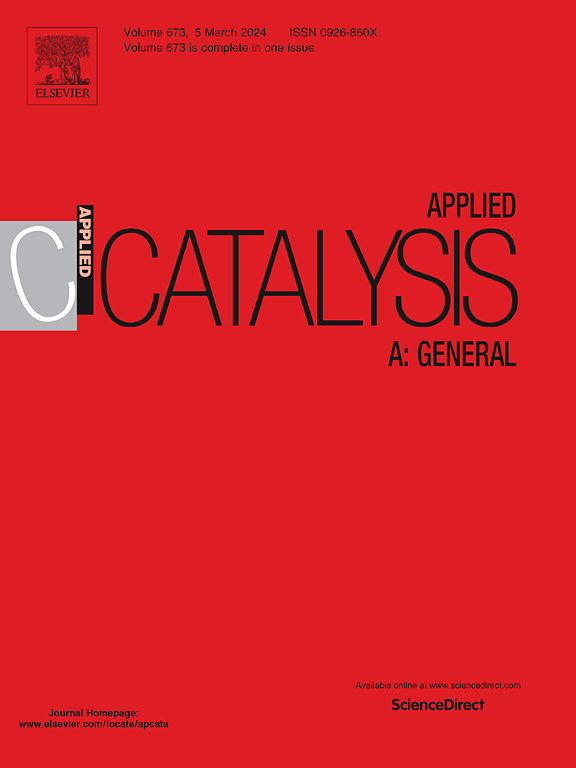Boosting the low-temperature activity and SOx-tolerance of Al-rich Cu-CHA zeolite in NH3-SCR via a simple pretreatment strategy
IF 4.8
2区 化学
Q2 CHEMISTRY, PHYSICAL
引用次数: 0
Abstract
Selective catalytic reduction of NOx with NH3 (NH3-SCR) requires catalysts combining superior low-temperature performance and high SOx tolerance in order to meet increasingly stringent regulations on heavy-duty diesel engine emissions. However, developing such catalysts is highly challenging. Herein, an Al-rich Cu-CHA zeolite was modified by a facile hydrogen pretreatment strategy, which resulted in boosted NOx conversions to ca. 78 and 90 % at 175 and 200 °C, respectively. Moreover, SOx (SO2/SO3=3/7) poisoning experiments revealed significantly higher SOx tolerance over the modified Cu-CHA catalyst versus the pristine catalyst. H2-TPR and kinetics analyses reveal that the pretreatment transformed aggregated CuxOy species into isolated Cu2+ ions, thereby creating numerous active sites and promoting low-temperature SCR reactivity. Furthermore, the presence of more isolated Cu2+ ions and fewer 8MR-Z-[Cu(OH)]+ species after the pretreatment considerably inhibits the deposition of copper sulfate species, thereby enhancing the SOx tolerance of the catalyst. In-situ DRIFTS demonstrates a higher number of key intermediate species (e.g., bridging/bidentate nitrates, NO+, and L-NH3) on the modified Cu-CHA catalyst, and it also shows a “fast SCR” reaction response. This results in an enhanced deNOx performance. Our study provides the feasibility of using a facile pretreatment strategy to develop effective SCR catalysts.
通过简单的预处理策略提高富铝Cu-CHA沸石在NH3-SCR中的低温活性和耐sox性
NH3选择性催化还原NOx (NH3- scr)需要具有优异低温性能和高SOx耐受性的催化剂,以满足日益严格的重型柴油机排放法规。然而,开发这种催化剂极具挑战性。本文采用简单的氢预处理策略对富al Cu-CHA沸石进行了改性,在175℃和200℃下,NOx转化率分别提高到78%和90% %。此外,硫(SO2/SO3=3/7)中毒实验表明,改性Cu-CHA催化剂对硫的耐受性明显高于原始催化剂。H2-TPR和动力学分析表明,预处理将聚集的CuxOy转化为分离的Cu2+离子,从而产生许多活性位点,并促进低温SCR反应活性。此外,预处理后的Cu2+离子束增多,8MR-Z-[Cu(OH)]+组分减少,显著抑制了硫酸铜组分的沉积,从而提高了催化剂对SOx的耐受性。原位漂移表明,改性Cu-CHA催化剂上的关键中间物质(如桥接/双齿硝酸盐、NO+和L-NH3)数量较多,并且表现出“快速SCR”反应响应。这将提高deNOx性能。本研究为开发高效SCR催化剂提供了一种简便的预处理策略。
本文章由计算机程序翻译,如有差异,请以英文原文为准。
求助全文
约1分钟内获得全文
求助全文
来源期刊

Applied Catalysis A: General
化学-环境科学
CiteScore
9.00
自引率
5.50%
发文量
415
审稿时长
24 days
期刊介绍:
Applied Catalysis A: General publishes original papers on all aspects of catalysis of basic and practical interest to chemical scientists in both industrial and academic fields, with an emphasis onnew understanding of catalysts and catalytic reactions, new catalytic materials, new techniques, and new processes, especially those that have potential practical implications.
Papers that report results of a thorough study or optimization of systems or processes that are well understood, widely studied, or minor variations of known ones are discouraged. Authors should include statements in a separate section "Justification for Publication" of how the manuscript fits the scope of the journal in the cover letter to the editors. Submissions without such justification will be rejected without review.
 求助内容:
求助内容: 应助结果提醒方式:
应助结果提醒方式:


